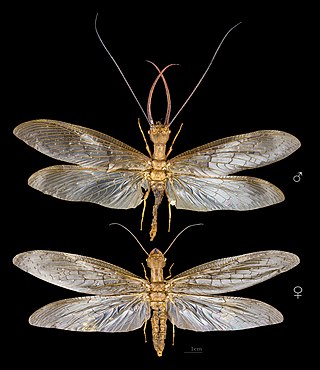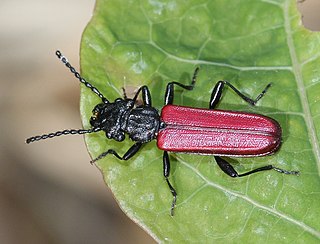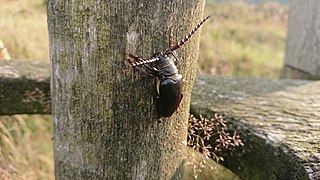
Bombardier beetles are ground beetles (Carabidae) in the tribes Brachinini, Paussini, Ozaenini, or Metriini—more than 500 species altogether—which are most notable for the defense mechanism that gives them their name: when disturbed, they eject a hot noxious chemical spray from the tip of the abdomen with a popping sound.

The insects of the beetle family Chrysomelidae are commonly known as leaf beetles, and include over 37,000 species in more than 2,500 genera, making up one of the largest and most commonly encountered of all beetle families. Numerous subfamilies are recognized, but the precise taxonomy and systematics are likely to change with ongoing research.

Harmonia axyridis is a large lady beetle or ladybug species that is most commonly known as the harlequin, Asian, or multicoloured Asian lady beetle. This is one of the most variable species in the world, with an exceptionally wide range of colour forms. It is native to eastern Asia, but has been artificially introduced to North America and Europe to control aphids and scale insects. It is now common, well known, and spreading in those regions, and has also established in Africa and widely across South America. This species is conspicuous in North America, where it may locally be known as the Halloween beetle, as it often invades homes during October to overwinter.

Darkling beetle is the common name for members of the beetle family Tenebrionidae, comprising over 20,000 species in a cosmopolitan distribution.

The sulphur-crested cockatoo is a relatively large white cockatoo found in wooded habitats in Australia, New Guinea, and some of the islands of Indonesia. They can be locally very numerous, leading to them sometimes being considered pests. A highly intelligent bird, they are well known in aviculture, although they can be demanding pets.

Sphaerites is a genus of beetles, the only genus in the family Sphaeritidae, sometimes called the false clown beetles. There are five known species, which are widespread in temperate areas of the Northern Hemisphere, found in forested or upland areas.

Pyrochroa coccinea, commonly known as the black-headed cardinal beetle, is a species of cardinal beetle in the family Pyrochoidae. It is found mainly in wooded areas and pastures throughout central Europe, including southern Great Britain. Similar to other species of Ambrosia beetles, P. coccinea live and reproduce on wooden logs in early stages of decomposition. Larvae develop over the span of many years, with overlapping generations often inhabiting a single wooden territory. Adults, however, are short-lived and exist during a brief season. They typically show up in April, become more populous in May and early June, and become very rare in the remaining months.

The Lauxanioidea are a superfamily of flies that includes the two large families, the Lauxaniidae and Chamaemyiidae, and the small family Celyphidae. Generally, they are small to medium, densely populated, coloured flies. The Chamaemyiidae live as parasites on insects. The family Celyphidae look like beetles.

Diabrotica undecimpunctata, the spotted cucumber beetle or southern corn rootworm, is a species of cucumber beetle that is native to North America. The species can be a major agricultural pest insect in North America. Spotted cucumber beetles cause damage to crops in the larval and adult stages of their life cycle. Larvae feed on the roots of the emerging plants, which causes the most damage since the young plants are more vulnerable. In the adult stage the beetles cause damage by eating the flowers, leaves, stems, and fruits of the plant The beetles can also spread diseases such as bacterial wilt and mosaic virus.

The family Corydalidae contains the megalopterous insects known as dobsonflies and fishflies. Making up about three dozen genera, they occur primarily throughout North America, both temperate and tropical, South America, Australia, New Zealand, Africa and Asia.

Cucujus is a genus of beetles in the family Cucujidae, the flat bark beetles. It contains 19 currently recognized species and subspecies.

Pyrrhalta viburni is a species of leaf beetle native to Europe and Asia, commonly known as the viburnum leaf beetle. It was first detected in North America in 1947 in Ontario, Canada. However, specimens had been collected in Annapolis Royal, Nova Scotia in 1924. In 1996 it was discovered in a park in New York, where native plantings of arrowwood were found to be heavily damaged by larval feeding. The UK-based Royal Horticultural Society stated that its members reported Pyrrhalta viburni as the "number one pest species" in 2010.

Ant nest beetles or paussines, some members of which are known also as flanged bombardier beetles, are a large subfamily within the ground beetles (Carabidae).The tribes Metriini, Ozaenini, Paussini and Protopaussini are included in the subfamily.

Calosoma sayi, also known as "Say's caterpillar hunter or "Black Caterpillar Hunter", is a species of ground beetle of the subfamily Carabinae. It was described by Pierre François Marie Auguste Dejean in 1826. A large, lustrous black beetle found throughout the United States, its habitat is fields and disturbed areas. About 25mm to 28mm long, its grooved elytra have rows of metallic dots or pits. Said pits are smaller than many Calosoma, and are ruby red. Both larvae and adults prey upon other larvae and pupae, specifically those of grubs, flies, and lepidoptera.

Lytta nuttalli, or Nuttall's blister beetle, is a species of North American beetle first described in 1824 by Thomas_Say. The genus Lytta is from a Latin word suggesting madness The specific nuttallii recognizes the contributions of Thomas Nuttall, a contemporary of Say.

Prionus laticollis, also known as the broad-necked root borer or broad necked prionus, is a root-boring longhorn beetle described by Dru Drury in 1773. It is widespread throughout eastern North America: its range covers a vast swath from Quebec in the northeast to Arkansas in the southwest.

Cucujus clavipes is known as the flat bark beetle. It is found throughout North America. These are generally found near tree line under bark of dead poplar and ash trees. C. clavipes are described as phloem-feeding and often predators of other small insects, such as wood-boring beetles, and mites. These are usually seen during spring-summer seasons. Having a cold habitat, these beetles must go through several physiological mechanisms to survive; they are recognised for their ability to change their overwintering mechanisms.

Pentaria is a genus of false flower beetles in the family Scraptiidae. There are about nine described species in Pentaria.
Chilocorus orbus is a species of lady beetle in the family Coccinellidae. It is native to North America. It is a black, domed beetle with two large red spots and is commonly called the twice-stabbed lady beetle or the two-stabbed lady beetle. Both adults and larvae feed on scale insects.

Galerita lecontei, the false bombardier beetle, is a species of ground beetle in the family Carabidae. It is found in the Caribbean Sea, Central America, North America, and the Caribbean. They are primarily characterized by their dark coloration, rapid movement, lifespan longevity, and nocturnal hunting behavior. Their elytra, which are the hardened forewings provide protection for their hind wings and exhibit a glossy texture. Many species within this family can secrete harmful chemicals as a defense mechanism against predators. Furthermore, this species has evolved various predator deterrents, often in the form of dischargeable glands near their abdominal area, a common feature across several beetle families, including Carabidae, Dytiscidae, and Gyrinidae.



















